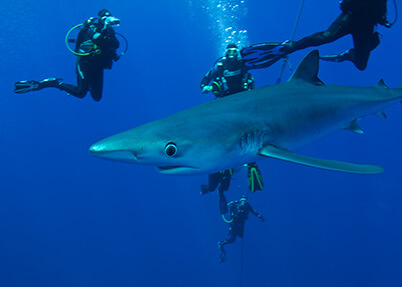
In NC You Might Even See Seafood Tech Inland
 |
| Look thar in the Piedmont Triad, Matey! It's a brightleaf shark! -- Shutterstock image |
The North Carolina Biotechnology Center has been expanding its support for marine biotechnology during the past decade, and it’s panning out.
Recent examples: In October 2015, the Marine Bio-Technologies Center of Innovation, which NCBiotech helped establish, partnered with NCBiotech’s Southeastern Office to host the international BioMarine Business Conference in Wilmington.
This annual international meeting, which is devoted to the commercial development of marine bioresources through business partnerships, was attended by more than 200 representatives from 19 different countries. It brought unprecedented attention to North Carolina’s marine biotechnology sector.
Then in October 2016, NCBiotech hosted the Second North Carolina Marine Biotechnology & Seafood Symposium.
With more than 300 miles of Atlantic coastline, 12,000 miles of estuarine shoreline and world-renowned university research centers for the study of marine life, North Carolina is becoming an increasingly important site for marine science and commerce.
NCBiotech helps Piedmont Triad companies "scale up"
But new life science technologies benefiting marine life are not only getting their sea legs on the coast.
As NCBiotech President and CEO Doug Edgeton pointed out in welcoming attendees to the Marine Biotechnology & Seafood Symposium, there’s even some exciting “fishy business” going on in the landlocked Piedmont Triad.
Three Triad companies are developing technologies that promise to greatly benefit marine life. And NCBiotech is helping 'em all “scale up!”
There’s a shark-saving company called SynShark, in Greensboro; a baitfish-saving company called Kepley BioSystems, also in Greensboro; and a salmon- and krill-saving company called Technology Crops International in Winston-Salem.
Squalene, squalene, over the bounding main
Every year an estimated three to five million sharks are slaughtered for a precious omega-2 oil in their livers called squalene, a clear liquid, lighter than water, that helps them float.
Squalene is in such high demand as a specialty chemical in the pharmaceutical, vaccine and cosmetics industries that as many as 30 million sharks will have to be "harvested" from the world’s oceans annually by 2019 to satisfy the growing market.
SynShark is developing a technology to instead harvest squalene from the leaves of tobacco plants that have been genetically engineered to synthesize the oil. The company is running field tests in Guilford County, near Greensboro, thanks to the partnership of our Piedmont Triad Office and to loan support from the Biotechnology Center.
Crabs, lobsters take the bait
Kepley Biosystems is using nanotechnology to develop OrganoBait, a synthetic crustacean bait that attracts crabs and lobsters into traps by smelling like decaying fish to them.
OrganoBait could ease the over-harvesting of forage fish, which are eaten by larger fish, birds and mammals. Forage fish are used not only for crab and lobster fishing, but for aquaculture and the production of Omega-3 fish oil supplements, livestock feed and cat food.
About 40 billion pounds of forage fish ̶ at least a third of the annual global harvest ̶ goes to crustacean fishing, and demand is growing, Kepley President Anthony Dellinger says. And declining stocks disrupt the ocean food web, depriving sea birds, whales, sea turtles, dolphins, seals and fish of a critical food source.
You say mahimahi, they say ahiflower
Technology Crops International is commercializing a new plant-based oil rich in nutritional omega fatty acids. Declining oil-fish stocks were presenting a new opportunity to provide plant-based sources of omega-3, -6 and -9 fatty acids.
The company’s AhiFlower Oil is derived from the ahiflower, a small herb native to the northern Middle East. The company’s tagline is “Better than flax. Not from fish.”
Even the Sandbar Oyster Company in Morehead City has landlubber roots. Its founders licensed patent rights from the University of North Carolina at Chapel Hill for new substrates that look like cement-garbed mesh, to improve production of oysters for consumer markets and to restore oyster habitats. The company is testing materials through research funded by the university’s Office of Technology Development.
Fascinating new technologies from improbable North Carolina venues. The world is our oyster.
